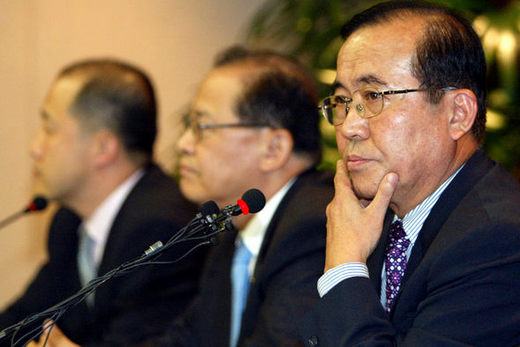 |
|
KDB's vice chairman Kim Jong-bae hears questions from reporters after having announced Shinhan Financial Group as the preferred bidder for LG Card on August 16.
|
Credit card firm’s sweep from bankruptcy to billions leaves only current creditors happy
Korea Development Bank (KDB) Wednesday has chosen Shinhan Financial Group as the preferred bidder to buy a controlling stake in LG Card, putting an end the the heated competition among financial companies to buy the nation’s largest card issuer.
In the process, LG Card has been reborn, valued at 7.2 trillion won (US$7.3 billion) just two and a half years since it effectively tanked.
Experts agree that it was the card’s new creditors who benefited most from the bidding process, not Shinhan Financial Group, since KDB will get to taste the fruits of years of financial overhaul efforts at LG Card, such as capital reduction and the resolution of rights issues. Financial sources estimate that the main creditors will earn profits between 3 and 3.2 trillion won from the sale, given the bidding price of 35,000 to 36,000 won per share.
"We are 110 percent satisfied," Kim Jong-bae, a KDB vice head, told a press conference.
Behind the gloating creditors, however, lie minority shareholders who lost their money during the card company’s prior crises, those who fell into credit delinquency and former LG Card employees who lost their jobs amid a harsh corporate restructuring process. In 2003, LG Card lost its market dominance, as its reckless issuance of cards and rising delinquency rate, combined with unfavorable outside factors, pulled down its bottom line. The crisis prompted the company to take measures aimed at raising funds worth 1 trillion won. But the fundraising efforts got nowhere, as LG Card again slipped into financial trouble, leading to a suspension of its cash advance service. Finally, the company asked for help from its creditors to inject around 2 trillion won in a last-ditch effort to salvage itself. But in the end, the government intervened and the Korea Development Bank came to rescue by taking the control of the embattled company. The state-run bank launched an array of measures aimed at overhauling the card company, but still could not prevent the overall losses of creditors and individual investors to the tune of 1 trillion won since the company was listed on the stock market in April 2004. Private investors and creditors were hit hard, but things were far worse for LG Card employees. In one-and-a-half years following the firm’s initial crisis, a total of 6,552 workers were forced to leave the company. Those employees who bought shares in the card with company loans had to face mounting debts; many fell into credit delinquency. Others had to pay back the debts with their severance money and leave the company without a penny in their pockets. The higher-than-expected bidding price for a controlling stake in LG Card is in part attributable to the fact that the bidders themselves were the creditors of the company. Sources say that they must have raised the bidding prices in a belief that it would be good to win the bid and if not, it would be no less good to see their shares in the credit card company rise. Indeed, Shinhan, Hana Financial Group, and the National Agricultural Cooperative Federation, which participated in the bidding process, own 7.14 percent, 4.17 percent, and 15 percent stake, respectively, in LG Card. Meanwhile, unionized workers at LG Card expressed displeasure with the high bidding price, saying, "The heavy acquisition cost could come as an obstacle to LG Card’s long-term growth."





